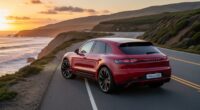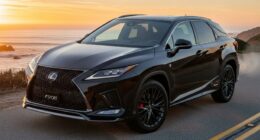Introduction: Mitsubishi’s Strategy for Affordable SUVs
The compact SUV market has become fiercely competitive, with automakers racing to balance performance, design, and affordability. Mitsubishi, a brand known for practicality and value, appears ready to re-enter this fight in 2025 with a smart move — bringing back a front-wheel-drive (FWD) version of the Outlander Sport.
By offering a more affordable variant, Mitsubishi aims to lower the entry price, attract budget-conscious buyers, and regain traction in markets dominated by Toyota, Honda, and Hyundai. Let’s take a closer look at what this FWD comeback could mean for the brand, the market, and everyday drivers.
Why Mitsubishi Is Considering a FWD Outlander Sport
The Mitsubishi Outlander Sport (also known as the ASX in some markets) has long been one of the brand’s best-selling SUVs. However, with prices of compact crossovers climbing steadily, many buyers are turning toward more affordable alternatives.
Mitsubishi’s potential reintroduction of a front-wheel-drive (FWD) version is a cost-cutting and market-smart decision. FWD models are typically:
-
Cheaper to manufacture (fewer components than AWD systems)
-
Lighter and more fuel-efficient
-
Easier to maintain
By eliminating the all-wheel-drive (AWD) system in select trims, Mitsubishi could drop the base price by several thousand dollars, putting it back in the sweet spot for first-time SUV buyers and urban drivers who don’t need AWD capability.
The Outlander Sport Legacy
Since its debut, the Outlander Sport has played a crucial role in Mitsubishi’s lineup. It’s smaller than the standard Outlander but still offers:
-
Comfortable seating for five
-
A versatile cargo area
-
Dependable performance for city and highway use
Its compact size and affordable price tag made it especially popular among younger buyers and small families.
However, with rising manufacturing costs and stricter emission standards, the Outlander Sport has faced pressure to stay competitive. Reintroducing a more efficient, lower-cost FWD version could rejuvenate interest and solidify its role as an entry-level SUV for the brand.
Performance and Efficiency — What to Expect
If Mitsubishi reintroduces the FWD Outlander Sport, it will likely share powertrains with the current lineup. Expect:
-
A 2.0-liter four-cylinder engine producing around 148 horsepower
-
A CVT (Continuously Variable Transmission) for smooth acceleration
-
Improved fuel efficiency due to reduced drivetrain weight
While AWD models excel in rough terrain and slippery conditions, the FWD setup offers better mileage and agility in everyday driving. It’s ideal for urban commuters and families who rarely venture off-road but still want the higher seating position and practicality of an SUV.
In short, this FWD option could offer the best of both worlds — crossover style and comfort, without the added AWD cost.
Lower Costs, Wider Appeal
The main attraction of this move is clear — price reduction. With car prices reaching record highs, the average consumer is more budget-aware than ever.
A base FWD Outlander Sport could start below $25,000, significantly undercutting competitors like the Honda HR-V, Mazda CX-30, or Toyota Corolla Cross.
This strategy would make Mitsubishi’s compact SUV accessible to a broader audience, especially:
-
Young professionals buying their first new car
-
Small families seeking practicality on a budget
-
Retirees looking for an easy-to-drive, low-maintenance crossover
By leveraging affordability, Mitsubishi can boost sales volume and rebuild its brand presence in North America and other competitive markets.
Design and Interior Updates
While affordability is key, the 2025 Outlander Sport is also expected to benefit from design and tech improvements inspired by Mitsubishi’s latest models.
Exterior Design
Expect sharper styling with:
-
A modernized Dynamic Shield grille
-
LED lighting upgrades
-
Refreshed bumpers and alloy wheel designs
These updates align the Outlander Sport’s aesthetics with Mitsubishi’s new design language, giving it a more premium and athletic appearance despite its budget focus.
Interior Comfort
Inside, the cabin will likely feature:
-
Soft-touch materials and improved seat fabrics
-
An updated infotainment system with Apple CarPlay and Android Auto
-
Advanced driver-assist safety systems such as lane-departure warning, adaptive cruise control, and automatic emergency braking
Even as a budget SUV, Mitsubishi understands that tech and safety features are essential for modern buyers.
Competing in a Crowded Market
The compact SUV market is one of the most competitive automotive segments today. Mitsubishi’s rivals include:
-
Toyota Corolla Cross
-
Honda HR-V
-
Mazda CX-30
-
Hyundai Kona
-
Kia Seltos
Each of these models emphasizes a blend of efficiency, design, and technology.
However, Mitsubishi’s advantage lies in offering value without compromise. If priced aggressively, the FWD Outlander Sport could attract consumers seeking dependable Japanese engineering at a lower cost than its rivals.
Environmental and Efficiency Benefits
The shift to FWD also plays a role in Mitsubishi’s sustainability goals. FWD vehicles:
-
Consume less fuel
-
Emit fewer CO₂ emissions
-
Require fewer components, reducing production footprint
While Mitsubishi continues developing hybrid and electric vehicles, improving the fuel efficiency of gasoline models remains an important step toward sustainability.
This aligns with the brand’s global goal to reduce overall emissions across its lineup by introducing smarter, lighter, and more efficient powertrains.
What This Means for Mitsubishi’s Future
Reintroducing a FWD Outlander Sport isn’t just about cutting costs — it’s a strategic move to rebuild momentum. After years of limited new releases, Mitsubishi seems ready to:
-
Expand its SUV lineup strategically
-
Target value-oriented markets
-
Strengthen its presence in North America
If successful, this could pave the way for similar affordable trim strategies across other Mitsubishi models like the Outlander or Eclipse Cross.
Conclusion: A Smart Comeback for Smart Buyers
The rumored FWD Mitsubishi Outlander Sport 2025 represents more than just a drivetrain change — it’s a reflection of how automakers are adapting to a price-sensitive and efficiency-driven market.
By focusing on affordability, practicality, and fuel efficiency, Mitsubishi is positioning itself to appeal to a new generation of buyers who want value without compromise.
If the rumors hold true, this budget-friendly comeback could mark the beginning of a revitalized era for Mitsubishi, proving that sometimes, less really is more.









